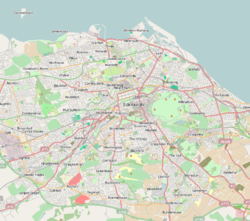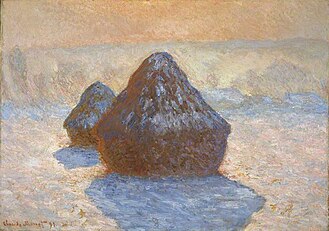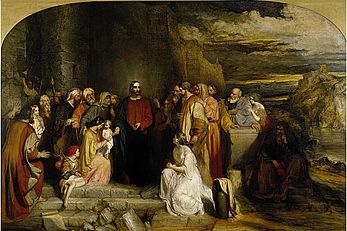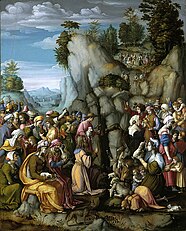Scottish National Gallery
 National Gallery of Scotland and Royal Scottish Academy Building, viewed from the South (2005) | |
| Established | 1859 |
|---|---|
| Location | The Mound Edinburgh Scotland United Kingdom |
| Coordinates | 55°57′3.24″N 3°11′44.38″W / 55.9509000°N 3.1956611°W |
| Visitors | 1,544,069 (2015)[1][2] |
| Public transit access | |
| Website | www |








The Scottish National Gallery is the national art gallery of Scotland. It is located on The Mound in central Edinburgh, in a neoclassical building designed by William Henry Playfair, and first opened to the public in 1859.[3] The gallery houses the Scottish national collection of fine art, including Scottish and international art from the beginning of the Renaissance up to the start of the 20th century.
History
The origins of Scotland's national collection lie with the Royal Institution for the Encouragement of the Fine Arts in Scotland, founded in 1819. It began to acquire paintings, and in 1828 the Royal Institution building opened on The Mound. In 1826, the Scottish Academy was founded by a group of artists as an offshoot of the Royal Institution, and in 1838 it became the Royal Scottish Academy (RSA). A key aim of the RSA was the founding of a national collection. It began to build up a collection and from 1835 rented exhibition space within the Royal Institution building.[3]
In the 1840s, plans were put in place for a new building to house the RSA.[3] William Henry Playfair was commissioned to prepare designs, and on 30 August 1850, Prince Albert laid the foundation stone.[4] The building was originally divided along the middle, with the east half housing the exhibition galleries of the RSA, and the western half containing the new National Gallery,[4] formed from the collection of the Royal Institution.[3] In 1912 the RSA moved into the Royal Institution building, which remains known as the Royal Scottish Academy Building. At this time, internal remodelling was carried out by William Thomas Oldrieve.[4] When it re-opened, the gallery concentrated on building its permanent collection of Scottish and European art for the nation of Scotland
Additional basement galleries were constructed in 1970.[4] In the early 21st century, the Playfair Project saw the renovation of the Royal Scottish Academy Building and the construction of an underground connecting space between the Gallery and the Academy Building. Construction took five years and cost £32 million.[5] The new underground space was opened as the Weston Link in August 2004.[6] Designed by John Miller and Partners, the link, now known as the Gardens Entrance, provides a new access from Princes Street Gardens and contains a lecture theatre, education area, shop, restaurant and an interactive gallery.[3]
Research
The research facilities at the Scottish National Gallery include the Prints and Drawings Collection of over 30,000 works on paper, from the early Renaissance to the late nineteenth century; and the reference-only Research Library. The Research Library covers the period from 1300 to 1900 and holds approximately 50,000 volumes of books, journals, slides, and microfiches, as well as some archival material relating to the collections, exhibitions and history of the National Gallery. The Print Room or Research Library can be accessed by appointment.
Collection
At the heart of the National Gallery's collection is a group of paintings transferred from the Royal Scottish Academy Building. This includes masterpieces by Jacopo Bassano, Van Dyck and Giambattista Tiepolo. The National Gallery did not receive its own purchase grant until 1903.
Key works of art displayed at the National Gallery include:
- Gian Lorenzo Bernini, Carlo Antonio dal Pozzo and Design for a Papal Monument
- Sandro Botticelli, Virgin Adoring the Sleeping Christ Child
- Antonio Canova, The Three Graces (displayed on rotation with the Victoria and Albert Museum in London)
- Paul Cézanne, The Big Trees and Montagne Sainte-Victoire
- Giambattista Pittoni, St Jerome and Peter of Alcantara
- Jean Siméon Chardin, Vase of Flowers
- John Constable, Dedham Vale
- Gerard David, Three Legends of St Nicholas
- Edgar Degas, Portrait of Diego Martelli
- James Drummond, The Porteous Mob and A Lady Descending from a Sedan Chair. Study for the Painting The Porteous Mob[7]
- Anthony van Dyck, The Lomellini Family
- Thomas Gainsborough, The Hon. Mrs Graham
- Paul Gauguin, Vision after the Sermon
- Hugo van der Goes, The Trinity Altarpiece (on loan from the Royal Collection)
- Francisco de Goya, El Medico
- El Greco, Saint Jerome in Penitence
- El Greco, Fábula
- El Greco, Christ Blessing (The Saviour of the World)
- Gavin Hamilton, Dawkins and Wood Discovering the Ruins of Palmyra
- Dominique Ingres, Mlle Albertine Hayard
- Claude Monet, Haystacks
- Nicolas Poussin, The Seven Sacraments
- Sir Henry Raeburn, The Reverend Robert Walker Skating on Duddingston Loch
- Allan Ramsay, Margaret Lindsay
- Raphael, Bridgewater Madonna
- Rembrandt van Rijn, A Woman in Bed and Self-Portrait
- Sir Joshua Reynolds, The Ladies Waldegrave
- Pieter Jansz Saenredam, Grote_Kerk,_Haarlem
- Georges Seurat, La Luzerne, St-Denis
- Titian, Venus Anadyomene, Diana and Callisto, Diana and Actaeon, The Virgin and Child with St John the Baptist and an Unidentified Saint, and The Three Ages of Man
- Joseph Mallord William Turner, Somer Hill and the Vaughan Bequest of 38 works
- Diego Velázquez, Old Woman Frying Eggs
- Johannes Vermeer, Christ in the House of Martha and Mary
- Antoine Watteau, Fêtes venetiènnes
Other artists represented in the collection include:
- David Allan
- Francis Bacon
- Federico Barocci
- William Blake
- David Young Cameron
- Gustave Courbet
- Aelbert Cuyp
- Eugène Delacroix
- Domenichino
- Albrecht Dürer
- William Dyce
- Adam Elsheimer
- John Emms[8]
- Andrew Geddes
- Vincent van Gogh
- Guercino
- James Guthrie
- Frans Hals
- Meindert Hobbema
- Hans Holbein the Younger
- Edward Atkinson Hornel
- Robert Scott Lauder
- Horatio McCulloch
- William York Macgregor
- William MacTaggart
- Lorenzo Monaco
- Berthe Morisot
- John Phillip
- Giovanni Battista Piranesi
- Camille Pissarro
- Robert Priseman
- David Roberts
- Peter Paul Rubens
- George Sanders
- William Strang
- Tintoretto
- Leonardo da Vinci
- Sir David Wilkie
- Francisco de Zurbarán
- Scottish National Gallery
-
Vision après le Sermon, Paul Gauguin
-
Frederic Edwin Church, Niagara Falls, from the American Side
-
Haystacks Claude Monet
-
St Jerome and Peter of Alcantara 1725 Giambattista Pittoni
-
Old Woman Frying Eggs Velazquez
-
Christ Teacheth Humility 1847 Robert Scott Lauder
-
Moses Striking the Rock 1525 Le Bacchiacca
-
Diana and Callisto Titian
-
The Quarrel of Oberon and Titania, 1849, by Joseph Noel Paton
See also
References
This article needs additional citations for verification. (May 2007) |
- ^ "Visits made in 2015 to visitor attractions in membership with ALVA". ALVA. Retrieved 9 March 2016.
- ^ a b Latest Visitor Figures, ALVA, 2014. Retrieved on 10 July 2014.
- ^ a b c d e "Scottish National Gallery - History & Architecture". Retrieved 27 January 2014.
- ^ a b c d "THE MOUND, NATIONAL GALLERY OF SCOTLAND WITH RAILINGS (Ref:27679)". Retrieved 27 January 2014.
- ^ "Playfair Project". National Galleries of Scotland. Retrieved 3 April 2012.
- ^ "Opening day for gallery project". BBC News. 4 August 2009.
- ^ National Gallery of Scotland, James Drummond
- ^ John Emms, National Gallery of Scotland.










